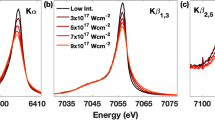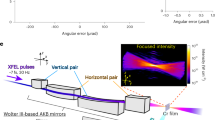Abstract
Since the invention of the laser, nonlinear effects such as filamentation1, Rabi cycling2,3 and collective emission4 have been explored in the optical regime, leading to a wide range of scientific and industrial applications5,6,7,8. X-ray free-electron lasers (XFELs) have extended many optical techniques to X-rays for their advantages of ångström-scale spatial resolution and elemental specificity9. An example is XFEL-driven inner-shell Kα1 (2p3/2 → 1s1/2) X-ray lasing in elements ranging from neon to copper, which has been used for nonlinear spectroscopy and development of new X-ray laser sources10,11,12,13,14,15,16. Here we show that strong lasing effects similar to those in the optical regime can occur at 1.5–2.1 Å wavelengths during high-intensity (>1019 W cm−2) XFEL-driven Kα1 lasing of copper and manganese. Depending on the temporal XFEL pump pulse substructure, the resulting X-ray pulses (about 106−108 photons) can exhibit strong spatial inhomogeneities and spectral splitting, inhomogeneities and broadening. Three-dimensional Maxwell–Bloch calculations17 show that the observed spatial inhomogeneities result from X-ray filamentation and that the broad spectral features are driven by sub-femtosecond Rabi cycling. Our simulations indicate that these X-ray pulses can have pulse lengths of less than 100 attoseconds and coherence properties that provide opportunities for quantum X-ray optics applications.
This is a preview of subscription content, access via your institution
Access options
Access Nature and 54 other Nature Portfolio journals
Get Nature+, our best-value online-access subscription
27,99 € / 30 days
cancel any time
Subscribe to this journal
Receive 51 print issues and online access
199,00 € per year
only 3,90 € per issue
Buy this article
- Purchase on SpringerLink
- Instant access to full article PDF
Prices may be subject to local taxes which are calculated during checkout




Similar content being viewed by others
Data availability
The processed experimental data used for generating Figs. 2, 3 and 4 are available at Zenodo (https://doi.org/10.5281/zenodo.15078615)47.
References
Hercher, M. Laser-induced damage in transparent media. J. Opt. Soc. Am. 54, 563 (1964).
Rabi, I. I. Space quantization in a gyrating magnetic field. Phys. Rev. 51, 652–654 (1937).
Gray, H. R., Whitley, R. M. & Stroud, C. R. J. Coherent trapping of atomic populations. Opt. Lett. 3, 218–220 (1978).
Bonifacio, R. & Lugiato, L. Cooperative radiation processes in two-level systems: superfluorescence. Phys. Rev. A 11, 1507–1521 (1975).
Boyd, R. W., Gaeta, A. L. & Giese, E. in Springer Handbook of Atomic, Molecular, and Optical Physics (ed. Drake, G.) 1097–1110 (Springer, 2008).
Couairon, A. & Mysyrowicz, A. Femtosecond filamentation in transparent media. Phys. Rep. 441, 47–189 (2007).
Chin, S. L. Femtosecond Laser Filamentation, Vol. 55 (Springer, 2010).
Ready, J. F. Industrial Applications of Lasers (Elsevier, 1997).
Chergui, M., Beye, M., Mukamel, S., Svetina, C. & Masciovecchio, C. Progress and prospects in nonlinear extreme-ultraviolet and X-ray optics and spectroscopy. Nat. Rev. Phys. 5, 578–596 (2023).
Rohringer, N. et al. Atomic inner-shell X-ray laser at 1.46 nanometres pumped by an X-ray free-electron laser. Nature 481, 488–491 (2012).
Yoneda, H. et al. Atomic inner-shell laser at 1.5-ångström wavelength pumped by an X-ray free-electron laser. Nature 524, 446–449 (2015).
Kroll, T. et al. Stimulated X-ray emission spectroscopy in transition metal complexes. Phys. Rev. Lett. 120, 133203 (2018).
Kroll, T. et al. Observation of seeded Mn Kβ stimulated X-ray emission using two-color X-ray free-electron laser pulses. Phys. Rev. Lett. 125, 037404 (2020).
Doyle, M. D. et al. Seeded stimulated X-ray emission at 5.9 keV. Optica 10, 513–519 (2023).
Zhang, Y. et al. Generation of intense phase-stable femtosecond hard X-ray pulse pairs. Proc. Natl Acad. Sci. USA 119, e2119616119 (2022).
Halavanau, A. et al. Population inversion X-ray laser oscillator. Proc. Natl Acad. Sci. USA 117, 15511–15516 (2020).
Chuchurka, S., Benediktovitch, A., Krušič, Š., Halavanau, A. & Rohringer, N. Stochastic modeling of x-ray superfluorescence. Phys. Rev. A 109, 033725 (2024).
Qi, P. et al. Sensing with femtosecond laser filamentation. Sensors 22, 7076 (2022).
Lee, Y., Oh, S.-W. & Han, S.-H. Laser-induced breakdown spectroscopy (LIBS) of heavy metal ions at the sub-parts per million level in water. Appl. Spectrosc. 66, 1385–1396 (2012).
Chin, S. L. et al. Advances in intense femtosecond laser filamentation in air. Laser Phys. 22, 1–53 (2012).
Young, L. et al. Femtosecond electronic response of atoms to ultra-intense X-rays. Nature 466, 56–61 (2010).
Hoener, M. et al. Ultraintense X-ray induced ionization, dissociation, and frustrated absorption in molecular nitrogen. Phys. Rev. Lett. 104, 253002 (2010).
Cryan, J. P. et al. Auger electron angular distribution of double core-hole states in the molecular reference frame. Phys. Rev. Lett. 105, 083004 (2010).
Fang, L. et al. Double core-hole production in N2: beating the Auger clock. Phys. Rev. Lett. 105, 083005 (2010).
Berrah, N. et al. Double-core-hole spectroscopy for chemical analysis with an intense X-ray femtosecond laser. Proc. Natl Acad. Sci. USA 108, 16912–16915 (2011).
Kanter, E. P. et al. Unveiling and driving hidden resonances with high-fluence, high-intensity X-ray pulses. Phys. Rev. Lett. 107, 233001 (2011).
Doumy, G. et al. Nonlinear atomic response to intense ultrashort X rays. Phys. Rev. Lett. 106, 083002 (2011).
Rudek, B. et al. Ultra-efficient ionization of heavy atoms by intense X-ray free-electron laser pulses. Nat. Photon. 6, 858–865 (2012).
Glover, T. E. et al. X-ray and optical wave mixing. Nature 488, 603–608 (2012).
Shwartz, S. et al. X-ray second harmonic generation. Phys. Rev. Lett. 112, 163901 (2014).
Huang, S., Ding, Y., Huang, Z. & Qiang, J. Generation of stable subfemtosecond hard x-ray pulses with optimized nonlinear bunch compression. Phys. Rev. Accel. Beams 17, 120703 (2014).
Ding Y. Generation of femtosecond to sub-femtosecond x-ray pulses in free-electron lasers. In Proc. SPIE 9512, Advances in X-ray Free-Electron Lasers Instrumentation III, Vol. 95121B (SPIE, 2015).
Li, S. et al. Characterizing isolated attosecond pulses with angular streaking. Opt. Express 26, 4531–4547 (2018).
Duris, J. et al. Tunable isolated attosecond X-ray pulses with gigawatt peak power from a free-electron laser. Nat. Photon. 14, 30–36 (2020).
Li, S. et al. Attosecond coherent electron motion in Auger-Meitner decay. Science 375, 285–290 (2022).
Guo, Z. et al. Experimental demonstration of attosecond pump–probe spectroscopy with an X-ray free-electron laser. Nat. Photon. 18, 691–697 (2024).
Franz, P. et al. Terawatt-scale attosecond X-ray pulses from a cascaded superradiant free-electron laser. Nat. Photon. 18, 698–703 (2024).
Driver, T. et al. Attosecond delays in X-ray molecular ionization. Nature 632, 762–767 (2024).
Yan, J. et al. Terawatt-attosecond hard X-ray free-electron laser at high repetition rate. Nat. Photon. 18, 1293–1298 (2024).
Bergmann, U. Stimulated X-ray emission spectroscopy. Photosynth. Res. 162, 371–384 (2024).
Mercadier, L. et al. Evidence of extreme ultraviolet superfluorescence in xenon. Phys. Rev. Lett. 123, 023201 (2019).
Benediktovitch, A. et al. Amplified spontaneous emission in the extreme ultraviolet by expanding xenon clusters. Phys. Rev. A 101, 063412 (2020).
Nandi, S. et al. Observation of Rabi dynamics with a short-wavelength free-electron laser. Nature 608, 488–493 (2022).
Autler, S. H. & Townes, C. H. Stark effect in rapidly varying fields. Phys. Rev. 100, 703–722 (1955).
Krušič, Š., Mihelič, A., Bučar, K. & Žitnik, M. Self-induced splitting of x-ray emission lines. Phys. Rev. A 102, 013102 (2020).
Gross, M. & Haroche, S. Superradiance: an essay on the theory of collective spontaneous emission. Phys. Rep. 93, 301–396 (1982).
Linker, T. et al. Data for attosecond inner shell lasing at angstrom wavelenghts. Zenodo https://doi.org/10.5281/zenodo.15078615 (2025).
Acknowledgements
We acknowledge the support from the LCLS and SACLA accelerator groups and their technical and engineering staff. We thank M. Seaberg and M. Hayes from the Coherent X-ray Imaging instrument. The use of Linac Coherent Light Source (LCLS), SLAC National Accelerator Laboratory, is supported by the US Department of Energy (DOE), Office of Science, Basic Energy Sciences (BES) DE-AC02-76SF00515 (T.M.L., Y.Z., T.F., C.W., F.D.F., A.A., R.A.-M., S.B., M.F.K. and U.B.). This work is supported by the US Department of Energy (DOE), Office of Science, Basic Energy Sciences (BES) DE-SC-0023585 (A.H., U.B. and C.P.); Office of Basic Energy Sciences (OBES), Division of Chemical Sciences, Geosciences and Biosciences (CSGB) under contract nos. DE-SC0023270 (T.M.L., Z.A. and U.B.); DE-AC02-05CH11231 (J. Yano and V.K.Y.); DE-SC-0063 (M.F.K.); the National Institutes of Health (NIH) grant nos. GM149528 (V.K.Y.), GM110501 (J. Yano), GM126289 (J.K.) and the Ruth L. Kirschstein National Research Service Award (F32GM116423; F.D.F.). The experiment at SACLA was performed with the approval of the Japan Synchrotron Radiation Research Institute (proposal nos. 2017B8066 and 2024A8055). We acknowledge JPSJ KAKENHI for grant nos. 19K20604, 22KK0233, 23K25131, 24K21199 (II) and 22K1813 (T.O.). I.I. acknowledges the financial support from JST PRESTO (JPMJPR24J1). SSRL Structural Molecular Biology Program is supported by the DOE Office of Biological and Environmental Research and the National Institutes of Health, National Institute of General Medical Sciences (including P41GM103393) (T.K.). The contents of this publication are solely the responsibility of the authors and do not necessarily represent the official views of NIGMS or NIH (T.K.). Computer resources for simulations were provided by the National Energy Research Scientific Computing Center (NERSC), a US DOE Office of Science User Facility located at Lawrence Berkeley National Laboratory, operated under contract no. DEAC02-05CH11231 using NERSC award ERCAP0020725. A.B., S.C. and N.R. acknowledge support from DESY, a member of the Helmholtz Association HGF. S.C. acknowledges the financial support of grant no. HIDSS-0002 DASHH (Data Science in Hamburg–Helmholtz Graduate School for the Structure of Matter). D.R. is part of the Max Planck School of Photonics, supported by the German Federal Ministry of Education and Research (BMBF), the Max Planck Society and the Fraunhofer Society. This work is supported by the Cluster of Excellence ‘CUI: Advanced Imaging of Matter’ of the Deutsche Forschungsgemeinschaft (DFG)—EXC 2056—project no. 390715994.
Author information
Authors and Affiliations
Contributions
N.R. and U.B. conceived the original research; J.K., J. Yano, V.K.Y., M.F.K. and C.P. participated in the design of the work. T.M.L., T.K., Y.Z., Y.M., Z.A., D.R., M.Y., I.I., T.O., J. Yamada, Y.I., G.Y., T.H., V.K.Y., H.Y. and U.B. performed the experiments at the SACLA; T.K., T.F., C.W., F.D.F., A.A., R.A.-M., S.B., M.W.G., A.M., A.A.L., V.K.Y. and U.B. performed the experiments at LCLS; G.B., D.S., F.N.S. and P.M.A. provided the Mn-loaded polymer composites for experiments at SACLA; Y.M. and H.Y. provided the Cu sulfate pentahydrate and Cu acetate samples for the experiments at SACLA; T.M.L. performed and analysed the 3D Maxwell–Bloch simulations supported by discussions with A.H., A.B. and S.C.; T.M.L. analysed the experimental data supported by discussions with A.H., A.B. and U.B.; T.M.L. and U.B. wrote the first draft of the paper; all authors participated in discussions and editing of the paper.
Corresponding authors
Ethics declarations
Competing interests
The authors declare no competing interests.
Peer review
Peer review information
Nature thanks the anonymous reviewers for their contribution to the peer review of this work. Peer reviewer reports are available.
Additional information
Publisher’s note Springer Nature remains neutral with regard to jurisdictional claims in published maps and institutional affiliations.
Extended data figures and tables
Extended Data Fig. 1 Filamentation in different samples.
Examples of filamentation taken at LCLS for different MnCl2 and Mn metal foils.
Extended Data Fig. 2 Observation of Mollow triplets.
Examples of Mollow triplets spectra at SACLA taken for Cu 7μm Foils. Further discussion and simulations in the Supplementary Information is provided to describe their formation.
Extended Data Fig. 3 Typical strong lasing spectra at SACLA.
25 random Strong Lasing Shots for Cu 20 μm Foils which all show broad and inhomogeneous spectra.
Supplementary information
Supplementary Information
This file contains Supplementary Figs. 1–21, Supplementary Tables 1–3 and additional experimental and theoretical descriptions.
Supplementary Video
Simulation of filamentation dynamics. Colour map represents the retarded time-integrated normalized intensity of the stimulated emission field with dark being low and bright being high.
Rights and permissions
Springer Nature or its licensor (e.g. a society or other partner) holds exclusive rights to this article under a publishing agreement with the author(s) or other rightsholder(s); author self-archiving of the accepted manuscript version of this article is solely governed by the terms of such publishing agreement and applicable law.
About this article
Cite this article
Linker, T.M., Halavanau, A., Kroll, T. et al. Attosecond inner-shell lasing at ångström wavelengths. Nature (2025). https://doi.org/10.1038/s41586-025-09105-9
Received:
Accepted:
Published:
DOI: https://doi.org/10.1038/s41586-025-09105-9



